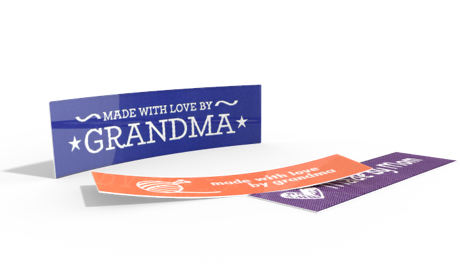![[Infographic] A Visual Guide to 12 Different Types of Sewing Needles [Infographic] A Visual Guide to 12 Different Types of Sewing Needles](/fileadmin/Blog/2016/Tipps_and_Inspiration/Different_needle_types/12_types_of_sewing_needles_infographic_small.jpg)
Let Wunderlabel help you with all your labeling needs! >>
1. THE UNIVERSAL NEEDLE
- USED FOR: These are the needles that probably came with your sewing machine. Used for general sewing, with a lightly rounded tip that is ideal for most types of fabrics and knits. Can be used for synthetic suede and synthetic leather. Commonly used on the following fabrics: many woven and some knits, fleece, nylon, linen, tulle, polyester, wool, velour, organza.
- SIZE & SHAPE: Have a slightly rounded tip, often sizes 10-16
2. THE BEADING NEEDLE
- USED FOR: As the name implies, this needle is used for beadwork! If you are attaching sequins to fabric or stringing beads for jewelry, this is the type of needle you'll use.
- SIZE & SHAPE: Long thin needle with a medium sized eye.
3.THE CHENILLE NEEDLE
- USED FOR: Ribbon / yarn / embroidery (especially crewel embroidery)
- SIZE & SHAPE: A long, thick needle with an eye large enough to use several strands of embroidery floss or yarn at one time. Sharp tip. From sizes 14-28.
4.THE DARNING NEEDLE
- USED FOR: Mending holes ... usually in wool socks, sweaters and jackets.
- SIZE & SHAPE: Long, average thickness with a large eye. Also referred to as tapestry needles. The large eyes of darning needles allow them to accommodate yarn when necessary. Not sharp.
5.THE SELF-THREADING NEEDLE
- USED FOR: General use — seams, hemming, attaching buttons. Used with many types of woven fabrics and some knit fabrics. Can also be used for synthetic suede and synthetic leather.
- SIZE & SHAPE: Length and thickness vary. These needles have a slit at the eye to allow thread to go into the eye without having to be threaded as with traditional hand needles. Good for those beginners or those with unsteady hands.
6.THE EMBROIDERY NEEDLE
- USED FOR: Decorative hand embroidery and crewel stitching. Encompasses several different types of embroidery needles, including crewel needles, tapestry needles, and chenille needles.
- SIZE & SHAPE: Average length and thickness with a large eye to accommodate embroidery floss and yarn.
7.THE LEATHER SEWING NEEDLE
- USED FOR: Leather, buckskin and suede (not synthetic leather). Hand leather needles are used primarily for decorative top stitching and for adding shank buttons to leather, buckskin and suede garments and accessories.
- SIZE & SHAPE: Varying length and thickness; triangular point; small eye. Chisel point or slightly twisted cutting edge on the tip is designed to easily pierce through hides.
8.THE MILLINERS’ NEEDLE
- USED FOR: Also known as «straw needle», these are used for decorative stitching, pleating and basting. The eye of the needle is no longer than the shaft.
- SIZE & SHAPE: An extra-long version of the sharp needle. Round eye and a sharp point.
9.THE UPHOLSTERY NEEDLE
- USED FOR: Working with thick-1 upholstery fabric and/or tying off quilts. Curved upholstery needles are used when working with a straight needle is awkward.
- SIZE & SHAPE: Thick, curved or straight needles. Straight upholstery needles can be from 3 to 12 inches long. Curved upholstery needles vary in length from 1 1/2 to 6 inches.
10.THE QUILTING NEEDLE
- USED FOR: Designed for sewing multiple fabric layers, often in cotton quilts.
- SIZE & SHAPE: Ultra-thin and long, with a sharp tip
11.THE JEANS/DENIM NEEDLE
- USED FOR: A machine needle used for denim jeans, twill, canvass material, and even for tight-weave and thick fabrics.
- SIZE & SHAPE: Slender eye with ultra-sharp point and sturdy shaft designed to work with hard and thick fabric like denim.
12.THE MICROTEX NEEDLE
- USED FOR: Used to pierce through fine yarns for superior topstitching, this needle is used for work with fine and delicate fabrics.
- SIZE & SHAPE: Ultra-sharp point.

























![[Infographic] A Visual Guide to 12 Different Types of Sewing Needles](/fileadmin/_processed_/f/5/csm_visual_guide_types_of_needles_header_c3d3eab124.png)

